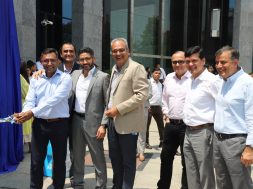Mobile access platforms at malls: revolutionising maintenance and marketing
MAPS technology is dramatically changing the way mall managers handle marketing display campaigns and maintenance cycles at malls
Shopping malls in India have become more than just ordinary organised retail spaces. Landmark regulatory changes and organic evolution of consumer preferences and demands have led to the emergence of a complete ‘shoppertainment’ experience. This experience fuelled by sprawling hypermarkets, boutique stores, electronic goods, food courts, multiplexes, salons and spas, gaming and entertainment plazas, events, concerts and even offices has become the hallmark of the modern family outing. The result – growing consumer response to professionally envisioned and executed mall spaces in the form of ever growing footfalls and a larger variety of retail brands willing to take the leap. But is mall management leveraging all its resources to synergise with the brands in their portfolio to the fullest?
Market dynamics are pushing towards ever bigger malls, not just horizontally in terms of gross leasable area but also vertically as malls grow taller from 3-4 storeys being the norm in the late 2000’s to 5-6 storey mega malls that stand tall today. As the malls grow bigger and the footfalls faster, maintenance, repair and operations costs grow making it essential for mall management and developers to activate new revenue streams and optimise existing ones. Mall space rental contracts are moving from fixed monthly rental schemes to revenue or profit sharing based contracts thus more directly linking the performance of the mall management team to the success of the retail environment they manage. The current focus on the details of mall design and aesthetics gives rise to wide and inviting circulation areas with high ceilings, clean facades and flowing displays. All this sets the scene for the usage and integration of new access and work at height technology at malls and shopping centres.
Marketing display spacesLeasing out marketing display spaces are a major source of revenue for malls and an excellent way for consumer brands to gain more exposure with the sort of footfalls malls attract on a daily basis. From standalone posters, hanging banners, elevator door prints, floor decals to gigantic outdoor displays hung on facades facing high traffic roads, marketing displays serve to both inform and influence consumers through point of purchase advertising. Brands also want to be able to refresh themselves frequently and let consumers know about their latest offerings by changing these displays regularly.
But as malls grow bigger and higher it becomes difficult to reach attractive display areas easily and frequently. Logistically, stores and brands install their own posters in the spaces made available to them by hiring third party vendors. In many display spaces this is a tedious, time taking and costly affair as vendors make use of unstable wood and rope structures along with a few skilled climbers to reach ceilings and high rise outdoor facades. The costs are so prohibitive and the process so elongated that brands reduce the frequency of changes in displays drastically and the demand and value of such spaces goes down. The barrier to usage needs to be reduced.
Some display areas are so difficult to access that many malls leave them unused despite their huge potential for example, the underbelly of escalators. The average mall visitor climbs 3-4 complete escalator sets (up and down) every visit. Combining this with average weekly footfalls brands are missing out on millions of potential impressions every week just because they are unable to reach this space.
Maintenance operationsMany malls are high activity areas that naturally see a build-up of dirt and residue on their indoor and outdoor facades. Whole atriums and circulation spaces, ceilings included need to be cleaned, top to bottom so that the mall can continue to present a fresh face to the non-stop barrage of people coming and going. This is something out of bounds of the regular day to day maintenance activities of the housekeeping staff at malls. Why? Because these places require people working at extremely high spots that do not have ready access. Again malls turn to third part vendors, their wood and rope structures and semi-skilled climbers. The process takes multiple night shifts with climbing structures being tediously built and unravelled every session. This shoots up maintenance costs, with cleanliness levels sustaining at just the bare acceptable levels.
Mobile Access Platform System (MAPS) technologyThe MAPS technology is a light weight and easy to use work at height solution that is already employed heavily in many industries and applications to reduce maintenance costs and minimise downtime. MAPS technology is dramatically changing the way mall managers handle marketing display campaigns and maintenance cycles at malls. It empowers mall management teams to carry out large scale maintenance work, reach more marketing display spaces and update them more frequently, all this, at a reduced cost and time to both the mall’s management and its stores.
Many malls have already turned to the MAPS technology to dramatically increase the frequency and reach of their marketing display campaigns and maintenance cycles. MAPS technology is revolutionary in terms of the fact that it not only allows mall management to better maintain their facilities and serve their clients in-house without having to deal with third party logistics vendors but also creates a new revenue stream. Malls can now charge a nominal fee for these services themselves and encourage brands and stores to reach out to new display spaces more frequently. How? Not only does this technology enable mall management to reach these places, it allows them to do so faster and with people who require lesser expertise and almost no training, in other words, their in-house maintenance and housekeeping staff. This is made possible by the fact that MAPS technology in modular in nature, can be used by anybody with little training, and is completely fool proof in terms of safety. No more do you need skilled climbers to reach those tough spots.
Standardisation and product qualityThe product varies from company to company and not all companies offer the same design, technical safety and operational advantages. Low cost knock-off products appeal to price conscience customers but end up in disastrous failures leading to loss of property and life. Because this is an un-standardised space as of yet in India, at least in the consumer facing space, mall management teams are unaware of industry standards that are typically used in manufacturing and production based applications. Due to the lack of Indian norms European and American design norms (look for both CE certification and EN1004 conformance) are typically followed by manufacturing and production industry insiders who understand due to the nature of their work how important it is to have a safe, durable product which saves them maintenance and repair operations costs and minimises downtime.
Product quality can be gauged by international certifications and quality Aardalloy material. Also look for precision welded joints, nylon wheels and a tools free erection process. Incidentally some of the best steel and aluminium access platform systems are those manufactured and designed in India, so be on the lookout for Indian brands in this space.
Another aspect of the issue that tends to slow down the adoption of such technology in the mall space in India is the fact that this is a paradigm shift in work at height solutions. We are still used to having all our work at height tasks done by experts who are skilled in climbing, because we have always associated such tasks with an element of danger and risk. By using technology to eliminate danger thereby making it possible for anyone to do this task MAPS technology makes the market more efficient by allowing people to add more value but whenever such a huge change comes in people have trouble adjusting. Mall management is unsure if really such a technology is safe for their people to work in. Will complications arise? Will the company be held liable for accidents? With a third party vendor these risks are outsourced. But the MAPS technology industry is making things more transparent and clear by certifying mall personnel on the use and maintenance of these products regularly, conducting surprise safety audits and ensuring a good level of after sales contact and feedback.
This simple but efficient use of technology is revolutionising the revenue streams and methodologies used in most brand activation and marketing campaigns in the mall space in India.
Authored by__
Pradeep Agarwal, CEO, Mtandt Group
Cookie Consent
We use cookies to personalize your experience. By continuing to visit this website you agree to our Terms & Conditions, Privacy Policy and Cookie Policy.









